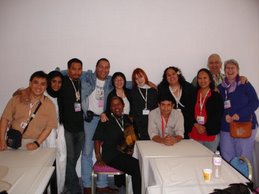Recording and preserving the Dakota language
A device resembling a small computer, called a phraselator, is being used to record and preserver the Dakota language. The electronic interpreter was first used in combat zones.By Jean Hopfensperger, Star Tribune
http://www.startribune.com/462/story/1293363.htmlWELCH, MINN.
Dakota language teacher Wayne Wells pulled a chair next to tribal elder Curtis Campbell, who had settled into his favorite living room rocker to begin an unusual recording session. Wells clutched a gray metal box called a "phraselator," an electronic interpreter first introduced in Iraq and Afghanistan for use by U.S. soldiers at military checkpoints and security zones. He handed a microphone to Campbell, and asked him to repeat -- in Dakota -- decidedly civilian phrases such as "I want some coffee."
Campbell responded, "Pezutasapa mak'u wo." And the words were added to a databank of hundreds of phrases and sentences stored in the device. Word by word, the effort is helping students at Prairie Island Indian Community preserve their fragile native language.
"There's only about two or three people here who speak Dakota fluently, so time is of the essence," said Wells, the language teacher at the community outside of Red Wing. "If the kids don't learn it now, there won't be anyone left who knows it."
Last year, the Prairie Island Community became one of more than 50 Indian communities nationwide to integrate phraselators into their arsenal of language preservation tools. The hand-held device resembles a small computer, with a monitor showing tabs for 'weather,"family,"animals" and "Dakota virtues and values," among other subjects.
"You can scroll up and down and find different phrases," explained 12-year-old Kachina Yeager, one of Wells' students, sitting on her front porch and fiddling with the tabs. "Say I want to hear the word for 'mother.' I can find it here and then tap it. Or I can just speak 'mother' into the top of the phraselator."
A few seconds after explaining this, Campbell's deep voice boomed "een na" out of the phraselator.
The first batch of phraselators was loaded with phrases in languages such as Arabic, Pashto and Farsi, said John Hall, president of VoxTec International, the device's Maryland-based manufacturer. The stock phrases would include "show me your hands" or "stay away from the area," he said. But a few years ago, it began catching on with Indian communities as well, Hall said.
Because Campbell is one of just a handful of native speakers left, he and Wells have spent hundreds of hours together in his living room decorated with tall Indian vases from the Southwest and Native American art on the walls.
Last week, the two were completing a section on food. The session showed the challenges of bringing ancient languages into modern times. Wells asked Campbell to translate, "I want some cake."There is no word for 'cake'," responded Campbell. "How about 'sweet bread'?" Ditto for "restaurant."How about 'food house'?" he asked.
Campbell, a retired construction worker, said he speaks Dakota fluently in part because of a lucky turn in his childhood.
Growing up in the 1940s, he was able to avoid being sent to a Indian boarding school, where children were beaten if they spoke their native language. He did, however, have to cut his long shiny hair in order to start school at a little one-room schoolhouse, he recalled, and had to learn to speak English fluently. But he continued to speak Dakota at home.
Wells wasn't so fortunate. He said his grandfather refused to speak Dakota with his children because he was so "traumatized" by the boarding school experience. So Wells learned Dakota at the University of Minnesota. He's still nowhere near fluent, but
recording with the phraselator is helping, he said.
Kachina's mother, Shelley Buck-Yaeger, has been so impressed with the device that she's planning to buy one for the family. Her parents didn't speak Dakota either, she said, and she's always wanted to learn.
Plus the phraselators are practically indestructible, a key feature given the wear and tear they can undergo at the hands of active children. Made for combat, they can be dropped 6 feet onto cement without damage, according to the VoxTech advertisements.
The phraselators aren't cheap: The cost of purchasing three of them, plus installing the software, and receiving training and technical support, was about $25,000, said Alan Childs, treasurer for the Prairie Island tribal council.
But the device can be used for more than just basic translation, he said. It can also preserve traditional Dakota songs and stories, said Childs, who is a singer in the community.
Over the years, there have been other attempts to preserve the Dakota language, which now only has about 100 fluent speakers in four Indian communities in Minnesota, Childs said. It's still too soon to tell whether the phraselators are going to make a breakthrough, he said. But a combination of a fancy high-tech tool and a dedicated teacher from the tribe could start making a difference, he said.
"You start building the wheel," Childs said, "and eventually it will start turning."











